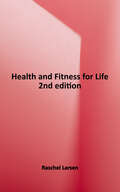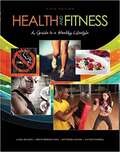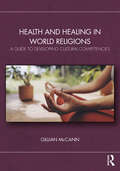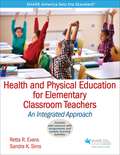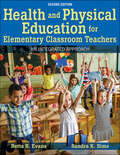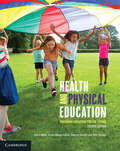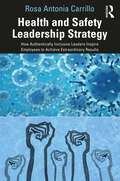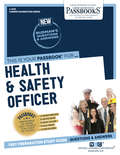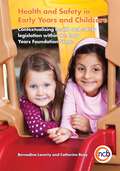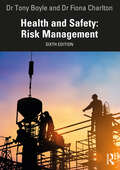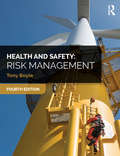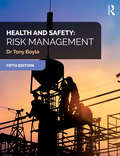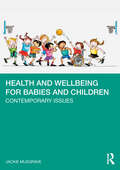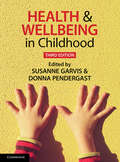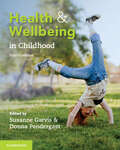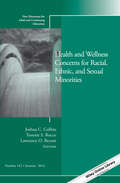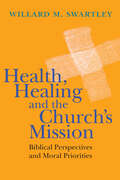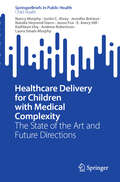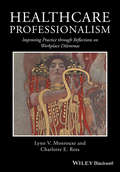- Table View
- List View
Health and Fitness for Life 2nd edition
by Raschel LarsenThis book is an introductory college textbook that shows students how to improve their habits related to physical activity, eating, or stress management. With a focus on real-world activities and practices for increasing overall wellness, this book includes grounded examples of practical health-based situations and healthy choices from diverse perspectives that will give students strategies for identifying and improving areas of their health. This book covers the basics of exercise and healthy living, as well as more advanced topics, including: -Cardiorespiratory fitness - Muscular strength and endurance - Flexibility training and mobility - Body composition - Nutrition planning and guidance - Stress management - Chronic and infectious disease - Substance use and abuse - Environmental health This book’s data-driven study of health and fitness is goal-oriented, instructive, and encouraging for students of varying backgrounds and states of wellness. The approach in these pages creates relevant links between guidance from official health organizations and everyday life. There’s something for everyone here, whether you’re looking to improve habits related to physical activity, eating, or stress management, or to better understand your place in the world as a healthy individual. Written by community college health faculty, Health and Fitness for Life blends down-to-earth instructional text with numerous examples of relevant situations and outcomes for students from all demographics.
Health and Fitness: A Guide to a Healthy Lifestyle
by Bounds Laura Darnell Gayden Brekken Shea Kirstin Agnor DottiedeeHealth and Fitness: A Guide to a Healthy Lifestyle provides a comprehensive look at health education for undergraduate students. This introductory text provides frank discussions of critical issues and helps you create a solid foundation for your students to make healthy behavioral choices. Health and Fitness incorporates a variety of in-class and notebook activities into the text. Illustrations and photos add to the learning experience. The adoption of a healthy lifestyle requires a focus on choices that will enhance the individual's potential to lead a productive, meaningful, and satisfying life.
Health and Healing in World Religions: A Guide to Developing Cultural Competencies
by Gillian McCannHealth and Healing in World Religions is a comprehensive introduction to the field that explores the research that links spirituality and well-being, including work with addiction and trauma.Each chapter includes an introduction to and summary of each tradition, questions at the conclusion, and boxes that highlight key ideas from the chapter using an example and interviews with medical professionals and other healers. Health and Healing in World Religions looks at cutting edge interfaces between spirituality and health such as mindfulness practices, addiction programmes, indigenous approaches to healing, traditional Chinese medicine, yoga and Ayurveda, and more. The text provides an overview of the research and practice all in one place and includes extensive bibliographies and resource guides for ease of reference.Health and Healing in World Religions is derived from over 20 years of teaching and research in health and healing and comes from an in-depth understanding of religion and spirituality. It is a vital guide to understanding cultural competency in the healing professions and the need to understand the cultural and spiritual traditions of clients.
Health and Physical Education Class 8 - Nepal
by Nepal Curriculum Development CentreThis accessible book has been published by ADRAD Nepal, with support of Australian Aid. All rights reserved. No part of this publication may be reproduced, stored in a retrieval system or transmitted, in any other form or by any means for commercial purpose without the prior permission in writing of the Curriculum Development Centre.
Health and Physical Education for Elementary Classroom Teacher: An Integrated Approach
by Retta Evans Sandra SimsIn elementary schools across the United States, teachers are often tasked with teaching health education or physical education, although they may not have specialist training. Health and Physical Education for Elementary Classroom Teachers: An Integrated Approach is the perfect resource for these educators. It covers both health and physical education while giving current and preservice teachers the skills to deliver appropriate lessons to their young students. <P><P>Retta Evans and Sandra Sims, respected educators and physical education advocates, provide everything teachers need in order to seamlessly incorporate health education and physical education into an integrated curriculum. Based on national health education, physical education, and state-specific academic standards including the Common Core state standards, this is a guide that will help teachers empower elementary students to become healthy and active. <P><P>The text is complemented with a full suite of ancillary products: <ul> <li>Sample syllabus and course outline</li> <li>Chapter resources, including an overview, outline, review questions with answers, and learning activities</li> <li>Chapter questions to help in creating quick assessments of student learning or in building custom tests</li> <li>Approximately 150 slides to reinforce key points</li> </ul> <P><P>The text also features lab exercises that allow students to practice the material they are learning, including designing their own standards-based lesson plans that integrate health and physical education. By learning the essential knowledge and using the invaluable strategies in this book, every teacher will be equipped to create a healthy and active school environment that maximizes student achievement. <P><P>Health and Physical Education for Elementary Classroom Teachers is organized into two parts, each dedicated to different components of incorporating health and physical education into the elementary classroom. <P><P>Part I focuses on the foundational knowledge needed for teaching health and physical education. It addresses the health risk behaviors of today’s generation of students, a team approach to coordinated school health, how physical growth and brain development in children are related to health, and the many characteristics and benefits of a high-quality physical education program. <P><P>Part II emphasizes the strategies necessary for incorporating health, physical education, and physical activity into the curriculum and school day. It discusses how teachers can become advocates of healthy and active schools, identify habits that promote everyday health in the classroom, and incorporate physical activity and the national standards into each school day. It also presents teaching methods, assessment tools, and evaluation strategies to ensure teaching success. <P><P>Throughout this book, practicing and training teachers will find websites, tips for best practices, sample lesson plans, and tables with innovative strategies. The result is a great resource that teachers can use to fulfill what is both a tremendous responsibility and a unique opportunity—promoting health and wellness in the elementary classroom using an integrated approach.
Health and Physical Education for Elementary Classroom Teachers: An Integrated Approach
by Retta R. Evans Sandra K. SimsIn elementary schools across the United States, many teachers tasked with teaching health education or physical education have not had training in these areas. Health and Physical Education for Elementary Classroom Teachers: An Integrated Approach, Second Edition, is the perfect resource for these educators. It covers both health and physical education while giving current and preservice teachers the skills to deliver appropriate lessons to their young students. <P><P> In this second edition, Retta Evans and Sandra Sims, respected educators and physical education advocates, provide everything teachers need in order to seamlessly incorporate health education and physical education into an integrated curriculum. Based on national health education, physical education, and state-specific academic standards, this is a guide that will help teachers empower elementary students to become healthy and active.
Health and Physical Education: Preparing Educators for the Future
by Judith Miller John Haynes Susan Wilson-Gahan Robyne GarrettHealth and Physical Education provides readers with the knowledge, understanding and skills required to successfully teach health and physical education in Australia. With emphasis on the development of movement competence and health literacy from the early years to secondary, this book brings together research, theory, curriculum and pedagogy in an engaging introduction for pre-service teachers. Now in its fourth edition, Health and Physical Education has been thoroughly updated, and features a new chapter covering ethics, morals the and duty of care and their practical application in school health and physical education. Maintaining strong connections to learners of all ages, the text links closely to the Early Years Learning Framework and the recently updated Australian Curriculum: Health and Physical Education. Each chapter is framed by the five propositions of the Australian Curriculum: Health and Physical Education, and includes vignettes, activities and discussion and review questions to encourage reflection and group work.
Health and Safety Leadership Strategy: How Authentically Inclusive Leaders Inspire Employees to Achieve Extraordinary Results
by Rosa Antonia CarrilloThe purpose of this book is to awaken leaders to the unique opportunities now present in the areas typically delegated to Health and Safety. It is a strategy to utilize existing resources to fully develop and engage human potential to catapult business achievement. The confluence of Covid-19, the resulting burnout, the attention on diversity, equity and inclusion generated by the Black Lives Matter movement and the ‘great resignation’ continues to create openings to fundamentally change how we address personal development, sustainable growth and social responsibility. The argument within is that the better we manage the social aspects of the organization, the better our business results. Elucidating to the reader the societal shifts of workplace culture in recent years, this text expertly analyzes the importance of mental health in the workplace, whilst also explaining how management and HR departments can improve. It examines who is responsible for generating psychological safety and provides relationship strategies that will improve performance. The critiques in this text establish why it is imperative for business leaders to concentrate on how their company culture affects their employees, and whether their employees feel safe, seen and supported. The concepts and practices in this book are the ones that leaders have used across the ages to create commitment, accountability and excellence. Managers will benefit from a deeper understanding of how these issues impact every aspect of organizational performance. This book is essential reading for executives, leaders and those interested in leadership. They could be in the C-suite, operations, health and safety and HR. It is also directly relevant to organization development and change management specialists interested in including safety within their practice.
Health and Safety Officer: Passbooks Study Guide (Career Examination Series)
by National Learning CorporationThe Health and Safety Officer Passbook® prepares you for your test by allowing you to take practice exams in the subjects you need to study. It provides hundreds of questions and answers in the areas that will likely be covered on your upcoming exam, including but not limited to: principles of personnel management and supervision; laws, rules, regulations and standards pertaining to health care administration; fiscal management; basic principles of emergency and disaster preparedness planning; and more.
Health and Safety in Early Years and Childcare: Contextualising health and safety legislation within the Early Years Foundation Stage
by Bernadina Laverty Catherine ReayThis practical guide demystifies health and safety in early years settings with a step-by-step guide to the law, compliance and practical application. Bringing together health and safety legislation and the welfare requirements within the revised Early Years Foundation Stage 2012, it successfully integrates health and safety within the EYFS. Including information taught on a variety of courses accredited by CACHE and BTEC, references to EYFS and Health and Safety legislation, specific guidance for childminders and audit tools for evaluation, it can be referred to as needs arise or used as an aid to inspection. This book is for all staff working within the Early Years Foundation Stage (EYFS) or environmental health. It will be useful for auditing, improving standards and preparing for inspection and it offers a clear outline of responsibilities within the legislative framework. It could also be used for in-house training or workshops.
Health and Safety in Early Years and Childcare: Contextualising health and safety legislation within the Early Years Foundation Stage
by Bernadina Laverty Catherine ReayThis practical guide demystifies health and safety in early years settings with a step-by-step guide to the law, compliance and practical application. Bringing together health and safety legislation and the welfare requirements within the revised Early Years Foundation Stage 2012, it successfully integrates health and safety within the EYFS. Including information taught on a variety of courses accredited by CACHE and BTEC, references to EYFS and Health and Safety legislation, specific guidance for childminders and audit tools for evaluation, it can be referred to as needs arise or used as an aid to inspection. This book is for all staff working within the Early Years Foundation Stage (EYFS) or environmental health. It will be useful for auditing, improving standards and preparing for inspection and it offers a clear outline of responsibilities within the legislative framework. It could also be used for in-house training or workshops.
Health and Safety: Risk Management
by Tony Boyle Fiona CharltonHealth and Safety: Risk Management is the clearest and most comprehensive book on risk management available today. This newly revised sixth edition takes into account new developments in legislation, standards and good practice. ISO 45001, the international health and safety management system standard, is given comprehensive treatment together with the guidance in ISO 45002. The latest ISO 10013 has also been addressed, however, ISO 45003 on psychosocial risk has been dealt with in a companion volume, Well-being and Wellness: Psychosocial Risk Management also by Boyle and Charlton.The book is divided into four main parts. Part 1.1 begins with a basic introduction to the techniques of health and safety risk management and continues with a description of ISO 45001. Part 1.2 covers basic human factors including how the sense organs work and the psychology of the individual. Part 2.1 deals with more advanced techniques of risk management including advanced incident investigation, audit and risk assessment, and Part 2.2 covers a range of advanced human factors topics including human error and decision making.This authoritative treatment of health and safety risk management is essential reading for both students working towards degrees, diplomas and postgraduate or vocational qualifications, and experienced health and safety professionals, who will find it invaluable as a reference.
Health and Safety: Risk Management
by Tony BoyleHealth and Safety: Risk Management is the clearest and most comprehensive book on risk management available today. This newly revised fourth edition integrates new developments in legislation, standards and practice, and incorporates up-to-date information for qualification syllabuses. The book is divided into four main parts. Part 1.1 is primarily concerned with the fundamentals of risk management and is relevant for all students of health and safety, while Part 1.2 covers the required basic human factors material required for health and safety qualifications. Part 2.1 deals with the more advanced aspects of risk management, while Part 2.2 covers the more advanced human factors material required by those studying for qualifications in health and safety. This authoritative treatment of risk management is essential reading for both students working towards degrees, diplomas and postgraduate or vocational qualifications in health and safety and experienced health and safety professionals, who will find it invaluable as a reference.
Health and Safety: Risk Management
by Tony BoyleHealth and Safety: Risk Management is the clearest and most comprehensive book on risk management available today. This newly revised fifth edition takes into account new developments in legislation, standards and good practice. ISO 45001, the international health and safety management system standard, is given comprehensive treatment, and the latest ISO 9004 and ISO 19011 have also been addressed. The book is divided into four main parts. Part 1.1 begins with a basic introduction to the techniques of health and safety risk management and continues with a description of ISO 45001. Part 1.2 covers basic human factors including how the sense organs work and the psychology of the individual. Part 2.1 deals with more advanced techniques of risk management including advanced incident investigation, audit and risk assessment, and Part 2.2 covers a range of advanced human factors topics including human error and decision making. This authoritative treatment of health and safety risk management is essential reading for both students working towards degrees, diplomas and postgraduate or vocational qualifications, and experienced health and safety professionals, who will find it invaluable as a reference.
Health and Wellbeing for Babies and Children: Contemporary Issues
by Jackie MusgraveThis evidence-based text explores children’s health and wellbeing from birth to adolescence, taking into account the familial, cultural, social, economic, environmental and global contexts of their lives. Divided into three parts, this book draws on an international body of research and theoretical perspectives on the determinants of health, such as hereditary, socioeconomic, environmental, geopolitical, gender and cross-cultural factors. It begins with an overview of child health and wellbeing before exploring global influences on health. The second part of the book focuses on health promotion and safeguarding. The final part looks at a range of health conditions that may impact children’s health, including infectious diseases, chronic health conditions and mental health. The book ends with a discussion of the role and contribution of families, carers, health professionals, hospitals, the wider community, charities and government, and examines how children with health needs and their families can best be supported. Each chapter includes critical questions, case studies and reflection points, all followed by a commentary to help the reader to think through the issues. Designed for all those working with children, or studying to work with children, Health and Wellbeing for Babies and Children: Contemporary Issues is ideal for students undertaking courses on public health nursing, children’s nursing, early years education, childhood studies and social work, among others.
Health and Wellbeing in Childhood
by Donna Pendergast Susanne GarvisThe period from birth to 12 years is crucial in a child's development and can significantly impact future educational success, resilience and participation in society. Health and Wellbeing in Childhood provides readers with a comprehensive introduction to a wide range of topics and issues in health and wellbeing education, including child safety, bullying and social emotional wellbeing, resilience, physical education, communication development and friendships. It explores relevant policies, standards and frameworks, including the Early Years Learning Framework and the Australian Curriculum. The third edition provides a cohesive and accessible reading experience and includes updated and expanded coverage of nutrition, body image and community partnerships. Each chapter has been revised to include the latest research and developments in childhood health and wellbeing, and features definitions of key terms, case studies, pause and reflect activities and end-of-chapter questions. Supplementary materials, including video and audio links, are available on the companion website.
Health and Wellbeing in Childhood
by Donna Pendergast Susanne GarvisHealth and Wellbeing in Childhood provides a fundamental introduction for educators in key priority areas of health and wellbeing education, including physical education, promoting health in childhood, and strengthening social and emotional learning in young children. It approaches each topic with childhood diversity and complexity in mind. The fourth edition has been comprehensively updated and continues to explore relevant standards and policies, including the revised Early Years Learning Framework. It includes a new chapter on executive functions in early childhood, focusing on the development of higher-order skills required for children to engage in purposeful and goal-directed behaviours. Each chapter features case studies that exemplify practice; spotlight boxes that provide further information on key concepts; and pause and reflect activities, end-of-chapter questions and learning extensions that encourage readers to consolidate their knowledge and further their learning.
Health and Wellness Concerns for Racial, Ethnic, and Sexual Minorities: New Directions for Adult and Continuing Education, Number 142 (J-B ACE Single Issue Adult & Continuing Education)
by Tonette S. Rocco Joshua C. Collins Lawrence O. BryantMinority status in the United States often accompanies diminished access to education, employment, and subsequently health care. This volume explores factors that have contributed to health disparities among racial, ethnic, and sexual minorities. Focused on developing strategies for understanding these disparities and promoting wellness in minority communities, the authors highlight social forces such as racism, ethnocentrism, sexism, and homophobia, which continue to influence not only access to and quality of care but also perception and trust of health care professionals. The authors identify several common themes, including the importance of communication, intentional and unintentional discriminatory structures, and perhaps most significantly, the role of culturally relevant learning sites.This is the 142nd volume of the Jossey Bass series New Directions for Adult and Continuing Education. Noted for its depth of coverage, it explores issues of common interest to instructors, administrators, counselors, and policymakers in a broad range of education settings, such as colleges and universities, extension programs, businesses, libraries, and museums.
Health and physical education Grade 07 - සෞඛ්යය හා ශාරීරික අධ්යාපනය 7 ශ්රේණිය
by A panel of experts of the ministry of education - අධ්යාපන අමාත්යාංශයේ විෂය විශේෂඥ මණ්ඩලයක් විසිනි.2016 වසරේ සිට 07 වන ශ්රේණියේ සෞඛ්යය හා ශාරීරික අධ්යාපනය විෂය සඳහා රජය විසින් නිර්දිෂ්ඨ ග්රන්ථයයි.
Health, Healing and the Church's Mission: Biblical Perspectives and Moral Priorities
by Willard M. SwartleyDoes the Christian community have the resources to develop a coherent response to health care challenges today? Accounting for biblical, theological and church-historical streams, Willard Swartley divulges a long tradition of healing and health care inherited by Christians today. Beginning with in-depth studies of Old and New Testament understandings of healing, the book surveys three millennia of biblical and theological teaching and practice in congregational life and mission. Along the way Swartley uncovers how Christians have understood the role of the church and other institutions in providing health and healing. The book concludes with an attempt to synthesize these biblical, historical and moral perspectives to help all Christians, including those in health care professions, respond to our current health care challenges.
Health: Making Life Choices
by Frances Sizer Webb Linda Kelly DebruyneMaking Life Choices is What Good Health is All About! Health: Making Life Choicesgives students the important decision-making skills and information they need to promote their own good health. It teaches the self-responsibility and skills needed to allow students to make wise lifestyle choices--the key to living a long and happy life. Topics include: Family Life, Dealing with Conflicts, Alternative Therapies, The Environment and Your Health, Teenagers and Violence, and Refusal Skills.
Healthcare Delivery for Children with Medical Complexity: The State of the Art and Future Directions (SpringerBriefs in Public Health)
by Andrew Robertson Jason Fox Nancy Murphy Justin C. Alvey Jennifer Brinton Natalie Heyrend Darro E. Avery Hill Kathleen Irby Laura Smals-MurphyThis book describes the state of the art of pediatric complex care, sharing the authors' decades of experience in an academic health center to illustrate points. The authors are pediatric generalist and subspecialist providers, among others, who care for children with medical complexity in a Pediatric Complex Care program. Children with medical complexity (CMC) are a small yet impactful pediatric population, a subset of children with special healthcare needs that include multi-system, non-categorical, chronic conditions, high resource and technology dependencies, medical fragility, and functional impairments. CMC do not fit into traditional systems of care. They require the continuous collaboration of pediatric subspecialists, community and public health partners, and family caregivers. The field of Pediatric Complex Care is rapidly evolving, yet lacks a well-prepared workforce built on clear educational competencies and clinical guidelines. In this compact volume, the authors review models of care for CMC, and how these models intersect with larger public health systems, dependent on collaborative networks of community-based and family partnerships. They explore ethical considerations, including implications for policy and practice. Among the topics covered are: The Specialty and Scope of Complex Care Pediatrics Ethical Considerations in the Care of Children with Medical Complexity Implications for Policy and Practice Healthcare Delivery for Children with Medical Complexity: The State of the Art and Future Directions is an essential resource for all medical professionals who care for CMC, public policy makers, medical educators, healthcare leaders, and community partners and stakeholders.
Healthcare Professionalism: Improving Practice through Reflections on Workplace Dilemmas
by Charlotte E. Rees Lynn V. MonrouxeHealthcare Professionalism: Improving Practice through Reflections on Workplace Dilemmas provides the tools and resources to help raise professional standards within the healthcare system. Taking an evidence and case-based approach to understanding professional dilemmas in healthcare, this book examines principles such as applying professional and ethical guidance in practice, as well as raising concerns and making decisions when faced with complex issues that often have no absolute right answer. Key features include: Real-life dilemmas as narrated by hundreds of healthcare students globally A wide range of professionalism and inter-professionalism related topics Information based on the latest international evidence Using personal incident narratives to illustrate these dilemmas, as well as regulatory body professionalism standards, Healthcare Professionalism is an invaluable resource for students, healthcare professionals and educators as they explore their own professional codes of behaviour.
Healthcare Science T Level: Core
by Mary Riley Stephen Hoare Gemma Roberts Stephanie FranceBegin your path to a career in Healthcare Science with this T Level textbook that covers all the core content you will need to understand to be successful in your qualification. Develop your understanding of the key principles, concepts and theories, as well as the skills and confidence to succeed in your written assessment and industry placement. Created in partnership with CACHE and written by highly respected authors Stephen Hoare, Stephanie France and Gemma Roberts, you can feel confident relying on the insights and experience of these experts.- Get started with short, clear summaries and learning outcomes at the beginning of each chapter- Track and consolidate your learning using 'Test Yourself' activities throughout each unit- Understand and remember key terms using the highlighted definitions- Contextualise your learning with case studies, reflection tasks and practice points- Approach assessment with confidence using the knowledge-based questions and scenario-based activities for practice, alongside model answers for the extended response questions
Healthcare Science T Level: Core
by Mary Riley Stephen Hoare Gemma Roberts Stephanie FranceBegin your path to a career in Healthcare Science with this T Level textbook that covers all the core content you will need to understand to be successful in your qualification. Develop your understanding of the key principles, concepts and theories, as well as the skills and confidence to succeed in your written assessment and industry placement. Created in partnership with CACHE and written by highly respected authors Stephen Hoare, Stephanie France and Gemma Roberts, you can feel confident relying on the insights and experience of these experts.- Get started with short, clear summaries and learning outcomes at the beginning of each chapter- Track and consolidate your learning using 'Test Yourself' activities throughout each unit- Understand and remember key terms using the highlighted definitions- Contextualise your learning with case studies, reflection tasks and practice points- Approach assessment with confidence using the knowledge-based questions and scenario-based activities for practice, alongside model answers for the extended response questions
